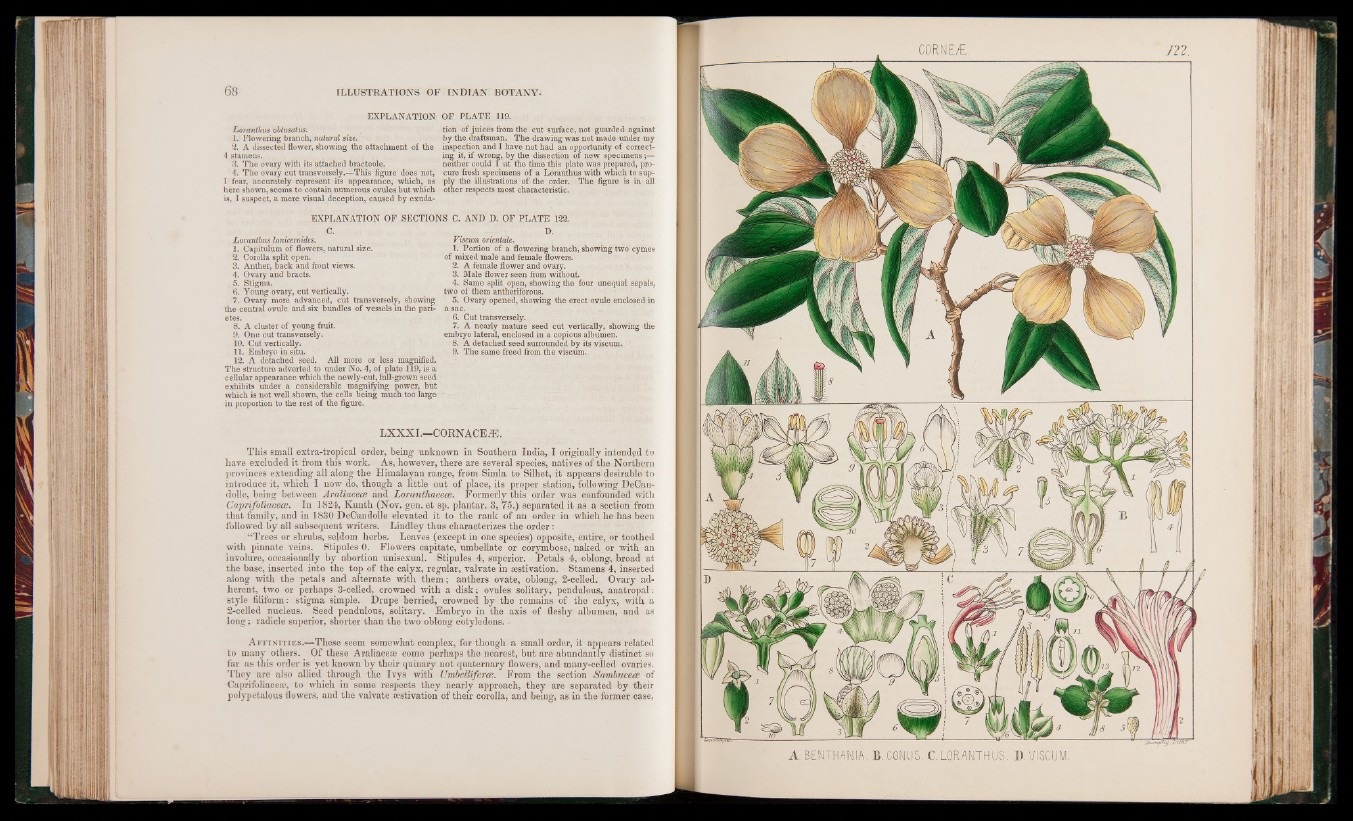
EXPLANATION OF PLATE 119.
Loranthus obtusatus.
1. Flowering branch, natural size.
2. A dissected flower, showing the attachment of the
4 stamens.
3. The ovary with its attached bracteole.
4. The ovary cut transversely.—This figure does not,
I fear, accurately represent its appearance, which, as
here shown, seems to contain numerous ovules but which
is, I suspect, a mere visual deception, caused by exudation
of juices from the cut surface, not guarded against
by the draftsman. The drawing was not made under my
inspection and I have not had an opportunity of correcting
it, if wrong, by the dissection of new specimens
neither could I at the time this plate was prepared, procure
fresh specimens of a Loranthus with which to supply
the illustrations of the order. The figure is in all
other respects most characteristic.
EXPLANATION OF SECTIONS C. AND D. OF PLATE 122.
C.
Loranthus loniceroides.
1. Capitulum of flowers, natural size.
2. Corolla split open.
3. Anther, back and front views.
4. Ovary and bracts.
5. Stigma.
6. Young ovary, cut vertically.
7. Ovary more advanced, cut transversely, showing
the central ovule and six bundles of vessels in the pari-
etes.
8. A cluster of young fruit.
9. One cut transversely.
10. Cut vertically.
11. Embryo in situ.
12. A detached seed. All more or less magnified.
The structure adverted to under No. 4, of plate 119, is a
cellular appearance which the newly-cut, full-grown seed
exhibits under a considerable magnifying power, but
which is not well shown, the cells being much too large
in proportion to the rest of the figure.
D.
Viscurn orientate.
1. Portion of a flowering branch, showing two cymes
of mixed male and female flowers.
2. A female flower and ovary.
3. Male flower seen from without.
4. Same split open, showing the four unequal sepals,
two of them antheriferous.
5. Ovary opened, showing the erect ovule enclosed in
a sac.
6. Cut transversely.
7. A nearly mature seed cut vertically, showing the
embryo lateral, enclosed in a copious albumen.
8. A detached seed surrounded by its viscurn.
9. The same freed from the viscurn.
LXXXI.—CORNACEiE.
This small extra-tropical order, being unknown in Southern India, I originally intended to
have excluded it from this work. As, however, there are several species, natives of the Northern
provinces extending all along the Himalayan range, from Simla to Silhet, it appears desirable to
introduce it, which I now do, though a little out of place, its proper station, following DeCan-
dolle, being between Araliacece and Loranthacece. Formerly this order was confounded with
Caprifoliacece. In 1824, Kunth (Nov. gen. et sp. plantar. 3, 75.) separated it as a section from
that family, and in 1830 DeCandolle elevated it to the rank of an order in which he has been
followed by all subsequent writers. Lindley thus characterizes the order :
“Trees or shrubs, seldom herbs. Leaves (except in one species) opposite, entire, or toothed
with pinnate veins. Stipules 0. Flowers capitate, umbellate or corymbose, naked or with an
involure, occasionally by abortion unisexual. Stipules 4, superior. Petals 4, oblong, broad at
the base, inserted into the top of the calyx, regular, valvate in aestivation. Stamens 4, inserted
along with the petals and alternate with them; anthers ovate, oblong, 2-celled. Ovary adherent,
two or perhaps 3-celled, crowned with a disk; ovules solitary, pendulous, anatropal:
style filiform: stigma simple. Drupe berried, crowned by the remains of the calyx, with a
2-celled nucleus. Seed pendulous, solitary. Embryo in the axis of fleshy albumen, and as
long; radicle superior, shorter than the two oblong cotyledons. •
A f f in it ie s .—These seem somewhat complex, for though a small order, it appears related
to many others. Of these Araliaceae come perhaps the nearest, but are abundantly distinct so
far as this order is yet known by their quinary not quaternary flowers, and many-celled ovaries.
They are also allied through the Ivys with Umbelliferce. From the section Sambucece of
Caprifoliaceae, to which in some respects they nearly approach, they are separated by their
polypetalous flowers, and the valvate aestivation of their corolla, and being, as in the former case,
C0R.NEÆ. J22.